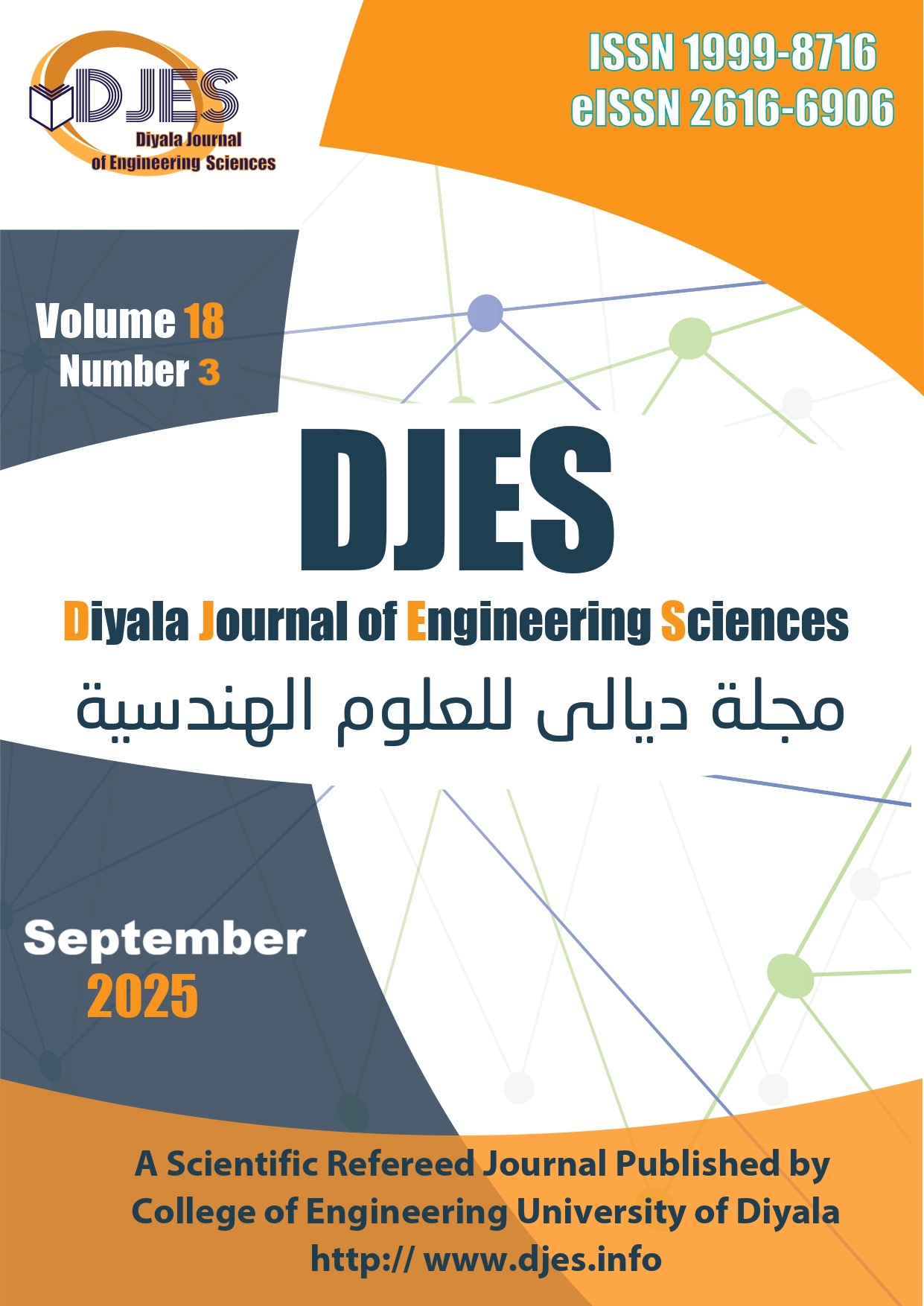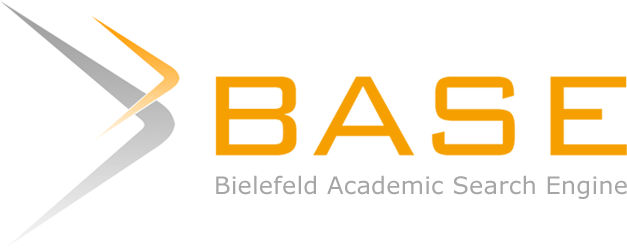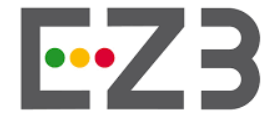Behavior of Deep Beams under Three-Point Loading – A Nonlinear Finite Element Investigation
DOI:
https://doi.org/10.24237/djes.2025.18314Keywords:
Strut and Tie method, Deep beams, Non-central loading, SAP2000 software, Load capacityAbstract
Even when applied at midspan, unequal loading is a major driver of deep-beam response and capacity. By contrast, with a central, equal load, the compression-strut paths that carry force from the supports to the loading node(s) are typically symmetric. However, in the present study, the load inequality causes these struts to be asymmetrical. As a result, the strut carrying the larger load failed before the one carrying the smaller load. Therefore, the deep beam fails early. Twenty-one deep beam specimens were analyzed using SAP 2000 software, which is based on the well-known finite element method. Three patterns of load distribution between three concentrated load points were adopted: 33%-33%-33%, 50%-25%-25%, 25%-50%-25%, 67%-16.5%-16.5%, 16.5%-67%-16.5%, 75%-12.5%-12.5% and 12.5%-75%-12.5%. These load cases were studied using different concrete's compressive strength values of 20, 30, and 40 MPa. Based on these results, load capacity remained essentially unchanged, while midspan deflection and shear stresses decreased by 4.0–4.6% and 3.8–17%, respectively; in contrast, the maximum positive moments increased by 0.55–7%.
Downloads
References
[1] American Concrete Institute (ACI), Building Code Requirements for Structural Concrete (ACI 318–14), Mater Struct, 2014.
[2] H. Hassan, M. Hassan, and M. Hatem, "Behavior of self-compact reinforced concrete deep beams with small shear span to depth ratio," MATEC Web of Conferences, vol. 162, 2018, Art. no. 01012, doi: 10.1051/matecconf/201816201012.
[3] Y. G. Abtan, H. F. Hassan, and H. F. Hassan, "A review of behavior of reinforced concrete deep beams," Journal of Engineering and Sustainable Development, vol. 24, no. 5, pp. 66-77, 2020, doi: 10.31272/jeasd.24.5.7.
[4] A. Aarabzadeh and R. Hizaji, "Failure mechanism in fixed-ended reinforced concrete deep beams under cyclic load," International Journal of Civil and Environmental Engineering, vol. 11, no. 4, pp. 562-566, 2017, doi: 10.1999/1307-6892/10007066.
[5] Q. M. Shakir and H. K. Hannon, "A novel hybrid model of reinforced deep concrete beams with curved hybridization," Jurnal Teknologi, vol. 85, no. 2, pp. 31-39, 2023, doi: 10.11113/jurnalteknologi.v85.2.12345.
[6] P. Baniya and S. Guner, "Specialized strut-and-tie method for rapid strength prediction of bridge pier caps," Engineering Structures, vol. 198, 2019, Art. no. 109474, doi: 10.1016/j.engstruct.2019.109474.
[7] Y, H, Atila Kumbasaroglu, and Ahmet İhsan Turan. "Torsional behavior of reinforced concrete beams with corroded reinforcement." Structures. Vol. 20. Elsevier, 2019.
[8] T. Roudsari, M., et al. "Experimental investigation of strengthening reinforced concrete moment resisting frames using partially attached steel infill plate." Structures. Vol. 19. Elsevier, 2019.
[9] A. A. D and A. Arabzadeh, "Experimental and analytical study on reinforced concrete deep beams," International Journal of Structural Engineering, vol. 10, no. 1, pp. 1-24, 2019, doi: 10.1504/IJSTRUCTE.2019.10020390.
[10] M. Re Rahimi, Mo. Ha Kheirabadi, and Amirhossein Ra., "Experimental and Analytical Study on Shear Behavior of Reinforced Concrete Deep Beams with Openings," ACI Structural Journal, vol. 119, no. 1, pp. 1-16, 2022, doi: 10.14359/51697386.
[11] U, Kojiro. "Concrete filled double skin tubular deep beam having outer circular and inner square sections under bending-shear." Structures. Vol. 14. Elsevier, 2018. doi:10.1016/j.istruc.2018.03.006
[12] M. Al-Jaberi, A. Al-Ali, A. Al-Nuaimi, and A. Al-Tamimi, "Behavior of Reinforced Concrete Deep Beams: Experimental Study and Numerical Modeling," ACI Structural Journal, vol. 118, no. 6, pp. 111-120, 2021, doi: 10.14359/51695908.
[13] F. F. Wafa and S. H. Aref, "Ultimate Strength Analysis of Reinforced Concrete Beams," Journal of Structural Engineering, vol. 121, no. 5, pp. 838-845, 1995, doi: 10.1061/(ASCE)0733-9445(1995)121:5(838).
[14] J. K. Wight and J. G. MacGregor,"Ultimate Strength and Ductility of Reinforced Concrete Beams,"ACI Structural Journal, vol. 88, no. 3, pp. 298-307, 1991, doi: 10.14359/2206.
[15] American Concrete Institute (ACI), Building Code Requirements for Structural Concrete (ACI 318-19), Farmington Hills, MI: ACI, 2019.
[16] American Association of State Highway and Transportation Officials, AASHTO LRFD Bridge Design Specifications, 9th ed., 2020.
[17] S. B. H. Sulaiman, A. M. Ibrahim, and H. J. Imran, “Study the Efficiency of the XGBoost Algorithm for Squat RC Wall Shear Strength Prediction and Parametric Analysis,” Diyala Journal of Engineering Sciences, vol. 17, no. 1, pp. 103–123, Mar. 2024, doi: 10.24237/djes.2024.17110
[18] S. J. Foster and R. I. Gilbert, "Experimental studies on high-strength concrete deep beams," ACI Structural Journal, vol. 95, no. 4, pp. 382–390, 1998, doi: 10.14359/554.
[19] M. D. Brown and O. Bayrak, "Design of deep beams using strut-and-tie models – Part I: Evaluating US provisions," ACI Structural Journal, vol. 105, no. 4, pp. 395–404, 2008.
[20] A. H. Abdulabbas and M. A. Ismael, "Structural behavior of reinforced concrete deep beams with inclined circular holes," Diyala Journal of Engineering Sciences, vol. 15, no. 3, pp. 66–74, 2022, doi: 10.24237/djes.2022.15307.
[21] K. S. Abdul-Razzaq and S. F. Jebur, "Suggesting alternatives for reinforced concrete deep beams by reinforcing struts and ties," MATEC Web of Conferences, vol. 120, no. 1, pp. 01004, 2017, doi: 10.1051/matecconf/201712001004.
[22] A.B. Matamoros and KH. Wong, "Design of simply supported deep beams using strut-and-tie models," ACI Structural Journal, vol. 100, no. 6, pp. 704–712, 2003.
[23] W. Kim and J. Jeon, "Decoupling of arch action in shear-critical reinforced concrete beams," ACI Structural Journal, vol. 108, no. 4, pp. 395–404, 2011.
[24] E. K. Sayhood, N. S. Mohammed, and A. S. Resheq, “Shear Strength Capacity of Reinforced Concrete Corbels,” Tikrit Journal of Engineering Sciences, vol. 31, no. 4, 2024.
[25] E. H. Hashim and H. F. Hassan, "Evaluating the Predicted Shear Strength of Concrete Deep Beams Reinforced with FRP Bars with/without Fibrous Concrete," Tikrit Journal of Engineering Sciences, vol. 32, no. 1, pp. 1–12, 2025.
Downloads
Published
Issue
Section
License
Copyright (c) 2025 Nawras Thamer, Khattab S. Abdul-Razzaq

This work is licensed under a Creative Commons Attribution 4.0 International License.












